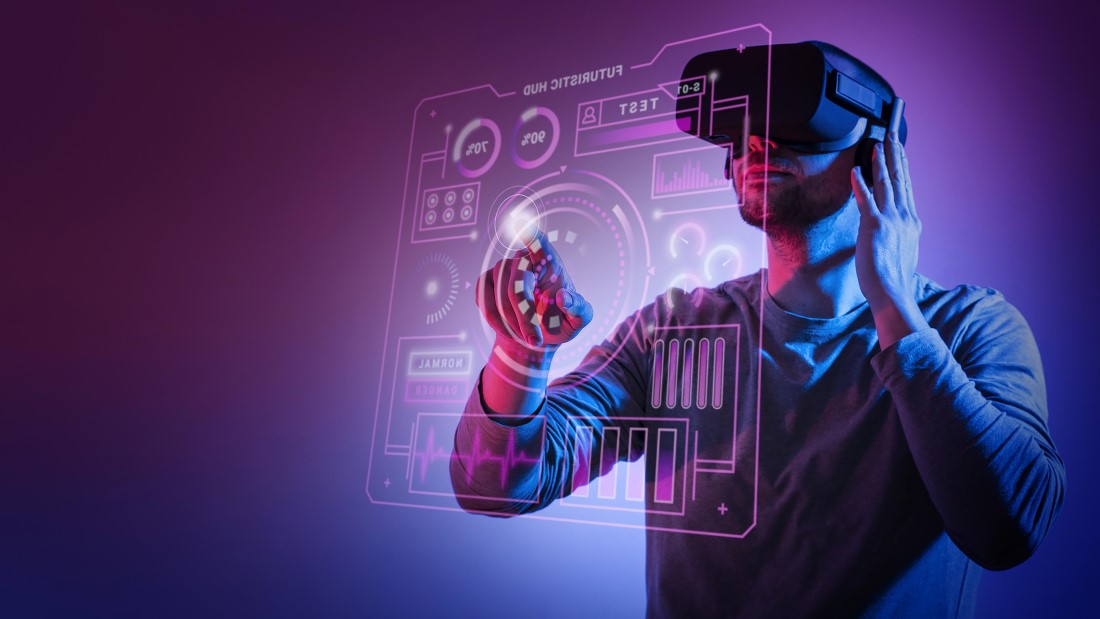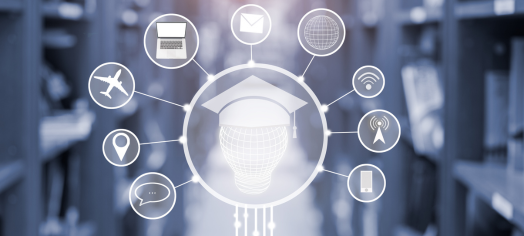Wondering how important technology in education is?
In today's digital age, technology has become an integral part of our lives, transforming various industries, including education.
The advent of technological advancements has brought about a paradigm shift in the field of education, revolutionizing the way knowledge is imparted, acquired, and accessed creating a digital divide.
This article aims to explore how technology has changed education and delve into the myriad ways it has reshaped the landscape of learning.
The Evolution of Technology in Education
Let’s have a look at how important technology in education is.
The journey of how technology has changed education can be traced back several decades, with the introduction of early educational tools used by educators such as slide projectors and overhead projectors.
However, the real revolution came with the advent of the personal computer.
With the proliferation of computers in schools, students gained access to a wealth of information previously unimaginable.
The internet further accelerated this revolution, providing a vast repository of knowledge at the click of a button.
The Changing Landscape

Today, technology has become an indispensable tool in education, touching every aspect of the learning process.
The journey of technology in education can be traced back several decades, with the introduction of early educational tools such as slide projectors and overhead projectors.
However, the real revolution in innovation technology came with the advent of the personal computer.
- With the proliferation of computers in schools, students gained access to a wealth of information previously unimaginable.
- The internet further accelerated this revolution, providing a vast repository of knowledge at the click of a button.
- Today, technology has become an indispensable tool in education, touching every aspect of the learning process.
- One of the most significant advancements in technology in education is the rise of online learning platforms.
- These platforms offer a wide range of courses and educational resources that can be accessed from anywhere, at any time.
- Students can now learn at their own pace and tailor their education to their individual needs.
- Online learning has also opened up opportunities for individuals who may not have access to traditional educational institutions, allowing them to acquire knowledge and skills remotely.
Traditional Education vs. Technology-Driven Education

The traditional education system relied heavily on textbooks, lectures, and classroom-based teaching methodologies.
However, technology-driven education has opened up a world of possibilities beyond these conventional methods.
- With the aid of technology, students can now engage in self-paced learning, accessing digital textbooks and multimedia content that caters to their individual learning styles.
- This shift from a one-size-fits-all approach to a more personalized and interactive learning experience has revolutionized education, fostering student engagement and motivation.
- Moreover, technology has made education more accessible than ever before.
- Online learning platforms have emerged, offering a multitude of courses ranging from academic subjects to specialized skills.
- This accessibility has extended education to individuals who may have previously been unable to pursue regular classroom-based learning due to various constraints.
- As a result, technology has democratized education, creating equal opportunities for all.
- Furthermore, technology-driven education has also enhanced collaboration and communication among students and educators.
- Through online platforms and tools, students can now collaborate on projects, share ideas, and receive feedback from their peers and teachers, regardless of geographical barriers.
- This virtual collaboration not only promotes teamwork and critical thinking skills but also prepares students for the digital workplace, where remote collaboration is becoming increasingly common.
The Impact of Technology on Teaching Methods
Technology has not only transformed how students learn but has also significantly impacted teaching methods.
Traditionally, teachers were the sole bearers of knowledge, imparting information through lectures and textbooks.
However, with the integration of technology into education, teachers have become facilitators and guides, fostering critical thinking and problem-solving skills in students.
- Technological tools such as interactive whiteboards, educational apps, and multimedia presentations have become invaluable assets in the modern classroom.
- These tools not only make learning more engaging but also allow teachers to tailor their E-lessons to the diverse needs of their students.
- With the ability to assess and track student progress in real-time, teachers can provide targeted interventions, ensuring that no child is left behind.
- Furthermore, technology has also opened up new avenues for collaboration and communication in the classroom.
- Online platforms and tools enable students to work together on projects, share ideas, and provide feedback to one another.
- This collaborative approach not only enhances their learning experience but also prepares them for the collaborative nature of the modern workforce.
- In addition, technology has made it possible for teachers to access a vast array of educational resources and materials.
- With just a few clicks, teachers can find videos, articles, and interactive simulations that supplement their lessons and provide additional context and examples.
- This wealth of resources allows teachers to bring real-world applications into the classroom, making learning more relevant and engaging for students.
Enhancing Learning Experiences through Technological Innovations
Let’s have a look at the role of technology in education.
Technological innovations have enhanced learning experiences by providing immersive and interactive environments.
1. Virtual Reality And Augmented Reality
Did you know that an overwhelming majority of students, approximately 97%, express a strong interest in enrolling in a virtual reality course?
Virtual reality (VR) and augmented reality (AR) have emerged as powerful tools, transforming abstract concepts into tangible learning experiences.
Through VR and AR, students can explore historical landmarks, delve into the depths of the ocean, or even dissect virtual organisms, all within the confines of a classroom.
These immersive experiences not only deepen understanding but also foster curiosity and a love for learning.
Furthermore, adaptive learning algorithms have revolutionized personalized learning by adapting content and assessments to suit the individual needs of students.
These algorithms analyze and track student performance, identifying areas of strengths and weaknesses, and providing personalized recommendations and feedback.
This tailored approach ensures that each student receives the support they require to maximize their learning potential.
2. Artificial Intelligence
In addition to VR and AR, another technological innovation that has enhanced learning experiences is the use of artificial intelligence (AI).
AI-powered chatbots and virtual assistants can provide immediate and personalized support to students, answering their questions and guiding them through complex concepts.
These AI-powered tools can also analyze student responses and provide real-time feedback, helping students identify and correct their mistakes.
3. Gamification
When it comes to the role of technology in education, gamification elements are important.
- The integration of gamification in education has transformed the way students engage with learning materials.
- Gamification involves incorporating game elements, such as points, badges, and leaderboards, into educational activities.
- This approach not only makes learning more enjoyable and interactive but also motivates students to actively participate and strive for improvement.
- By turning learning into a game, students are more likely to retain information and develop a deeper understanding of the subject matter.
Exploring the Benefits of Technology in Education
When it comes to how technology has changed education, there are a number of benefits.
1. Enhanced Interactivity
Firstly, technology enhances student engagement by making learning more enjoyable and interactive.
Gamification, for instance, incorporates game elements into educational activities, motivating students and transforming learning into a fun and engaging process.
This approach not only fosters a love for learning but also develops essential skills such as problem-solving, collaboration, and critical thinking.
2. Increased Digital Knowledge
Additionally, technology equips students with essential 21st-century skills that are crucial in today's fast-paced world.
Through the use of digital tools and resources, students learn to navigate the digital landscape, communicate effectively, and think critically.
These skills are highly sought after in the job market and are essential for success in the modern knowledge-based economy.
3. Personalized Learning Experiences
Furthermore, technology in education promotes personalized learning experiences.
With the help of adaptive learning platforms and intelligent tutoring systems, students can receive customized instruction tailored to their individual needs and learning styles.
This personalized approach allows students to progress at their own pace, ensuring that they fully grasp the concepts before moving on to the next topic.
As a result, students are more likely to retain information and achieve better academic outcomes.
Empowering Students with Digital Tools and Resources

Let’s have a look at how technology has changed education when it comes to empowering students.
Technology empowers students by providing them with a plethora of digital tools and resources that enhance their learning journey.
With access to online libraries, educational websites, and open educational resources, students can explore and acquire knowledge beyond the confines of their textbooks.
This exposure to diverse perspectives and information cultivates critical thinking and a thirst for lifelong learning.
Harnessing the Power of Virtual Learning Environments
Virtual learning environments have gained significant traction in recent years, especially with the COVID-19 pandemic necessitating remote learning solutions.
These environments provide a seamless online platform where students can access course materials, interact with teachers and peers, and submit assignments.
Through features such as discussion boards, video conferencing, and collaborative tools, virtual learning environments foster a sense of classroom community and facilitate meaningful learning experiences, even when physical classrooms are not viable.
The Rise of Online Education and E-Learning Platforms
Online education and e-learning platforms have witnessed a meteoric rise in recent years, opening up a world of educational opportunities for individuals of all ages and backgrounds.
These platforms offer a wide range of courses and programs, spanning diverse subjects and fields, catering to the specific needs and interests of learners.
Moreover, online education provides the flexibility and convenience of self-paced learning, allowing individuals to balance their educational pursuits with other commitments.
Revolutionizing Classroom Dynamics with Educational Technology
Educational technology has revolutionized classroom dynamics, transforming the traditional teacher-centric model into a more student-centered approach.
Through flipped classrooms, students can access instructional materials and lectures online before class, allowing classroom time to be utilized for discussions, collaborative activities, and problem-solving.
This shift from passive learning to active learning promotes higher-order thinking skills and deeper understanding.
Bridging the Gap: How Technology Promotes Inclusivity in Education
Technology has played a pivotal role in bridging the gap and promoting inclusivity in education.
Assistive technologies, such as screen readers, speech recognition software, and tactile devices, have made education more accessible for individuals with disabilities, leveling the playing field and providing equal educational opportunities.
Furthermore, technology has allowed for personalized accommodations for students with diverse learning needs.
Through adaptive learning platforms, students with learning disabilities or those requiring additional support can access tailored content, interventions, and accommodations that enable them to thrive academically.
Engaging Students through Gamification and Interactive Learning Tools
Gamification and interactive learning tools have transformed the learning experience by making it more engaging and immersive.
Gamification incorporates game elements, such as rewards, competition, and challenges, into educational activities, motivating students and fostering a sense of achievement.
Through interactive learning tools, such as simulations and educational games, students can explore complex concepts and experiment in a risk-free environment, enhancing comprehension and retention.
Personalized Learning: Customizing Education with Technology
Personalized learning, enabled by technology, is a powerful approach that tailors education to the unique needs and preferences of individual students.
Adaptive learning algorithms analyze student performance data, identifying areas for improvement and providing customized content, exercises, and assessments.
By addressing individual learning gaps and challenges, personalized learning maximizes student success and fosters a love for continuous learning.
Overcoming Challenges in Implementing Technological Solutions for Education
While the integration of technology in education has brought about numerous benefits, it has also presented challenges that must be addressed.
- One such challenge is ensuring adequate digital infrastructure and accessibility for all students, particularly those belonging to marginalized communities.
- This includes providing access to reliable internet connectivity, devices, and necessary software.
- Implementing technological solutions in education also requires robust professional development and training for educators.
- Teachers need to be equipped with the necessary skills and knowledge to integrate technology effectively into their classrooms, ensuring optimal utilization and achieving desired learning outcomes.
The Future of Education: Trends and Innovations in EdTech
The future of education promises to be even more technology-driven, with innovative trends reshaping the educational landscape.
- Artificial intelligence (AI) and machine learning (ML) are poised to play a significant role in education, offering personalized learning experiences, intelligent tutoring, and automated assessments.
- Additionally, adaptive learning technologies will continue to evolve, providing even more tailored content and interventions that cater to individual student needs.
- The rise of immersive technologies, including virtual reality and augmented reality, will make learning even more experiential and engaging.
- As these technologies become more accessible and affordable, they hold immense potential for transforming education, particularly in fields that require hands-on experiences, such as science, engineering, and medicine.
Ensuring Cybersecurity and Data Privacy in Educational Technologies
As technology becomes increasingly integrated into education, it is of utmost importance to ensure cybersecurity and protect the privacy of student data.
Educational institutions must implement robust security measures, including encryption, access controls, and regular security audits, to safeguard sensitive information.
Moreover, clear policies and guidelines should be established to govern the collection, storage, and usage of student data, ensuring transparency and fostering trust.
Empirical Evidence: The Impact of Technology on Student Performance
There is a growing body of empirical evidence that highlights the positive impact of technology on student performance.
Numerous studies have shown that technology integration improves student engagement, motivation, and achievement.
Additionally, technology-enabled personalized learning approaches have been found to enhance student outcomes and narrow achievement gaps.
It is important to note, however, that the successful integration of technology in education goes beyond mere access to devices and resources.
Effective pedagogical practices, guided by evidence-based research, must be employed to leverage the full potential of technology and maximize student learning outcomes.
Transforming Assessment and Evaluation with EdTech Solutions
Technology has the potential to revolutionize assessment and evaluation practices in education.
Traditional forms of assessment, such as pen-and-paper examinations, often fall short of capturing the diverse skills and competencies that students possess.
Through the use of educational technology, alternative forms of assessment, such as project-based assessments, e-portfolios, and peer evaluations, can be implemented, providing a more holistic picture of student learning and growth.
Fostering Collaboration and Communication Skills through the Impact of Technology on Education
Let’s have a look at the impact of technology on education.
Technological integration in education fosters collaboration and communication skills among students.
Through collaborative tools, online discussion forums, and project-based learning activities, students can work together, regardless of geographical location, to solve complex problems and develop a deeper understanding.
These collaborative experiences not only enhance teamwork and interpersonal skills but also prepare students for the collaborative nature of the modern workplace.
In conclusion, the impact of technology on education cannot be overstated.
It has ushered in a paradigm shift, transforming the way knowledge is disseminated, acquired, and accessed.
From personalized learning experiences to promoting inclusivity and preparing students for the future, technology has proven to be a powerful tool in revolutionizing education.
As we continue to embrace the possibilities offered by technology, it is important to strike a balance, ensuring that pedagogy remains at the heart of education, guiding the effective integration of technology-based solutions.
Unleash the Potential for Growth and Learning with Oreed's Education Intelligence Platform
Step into a world of endless possibilities and boundless growth with Oreed's groundbreaking Education Intelligence Platform.
Discover a transformative tool that propels your educational journey forward, empowering you to reach new heights of knowledge and success.
1. Amplify Employee Awareness and Unlock a Holistic Perspective with Oreed
Unleash the full potential of your workforce and gain a comprehensive 360-degree view of your employees like never before, courtesy of Oreed.
Ignite a culture of awareness within your organization, fueling well-informed decisions that benefit both your employees and your company's success.
2. Empower Your Team with Tailored Training and Personalized Courses
Fuel your team's growth and success with Oreed's cutting-edge tools for customized training and courses.
Dive deep into the unique training needs of your employees and craft targeted programs that foster their development.
With Oreed, every team member receives the precise training required to excel in their roles and achieve greatness.
3. Measure the Impact and Effectiveness of Training with Oreed's Advanced Analytics
Unleash the power of data and gain unparalleled insights into the impact and effectiveness of your training initiatives using Oreed's advanced analytics and reporting capabilities.
Harness these valuable metrics to continuously refine your training and development efforts, ensuring optimal results and maximizing the value delivered to your employees and organization.
4. Elevate Your Business with Oreed's ROI Promise
Elevate your business to unprecedented heights of success with Oreed's game-changing platform.
Prepare for a transformative journey as our ROI promise guarantees a substantial 10x increase in customer revenue and engagement.
Empower your organization with enhanced employee productivity and improved operational efficiency, setting the stage for seamless operations across every facet of your business.
Don't settle for average outcomes when you can unlock the extraordinary power of Oreed. Embrace the future of growth, learning, and success today.
So what are you waiting for? Book a demo with Oreed today and find out more about our features.
Promote lifelong learning through Oreed by experiencing the most powerful all-in-one training and development intelligent platform that streamlines all your organization's learning, training, and development activities in one place.


![Learning Experience Platform Market Size [2024]](/cdn/1619638329_6089b83993722/1658391437_62d90b8d45216/1658391471_62d90baf0898f/1702465413_65798f85e1464/1702465413_65798f85e1078.jpeg)
![What is a Learning Experience Platform [2024 Full Guide]](/cdn/1619638329_6089b83993722/1658391437_62d90b8d45216/1658391471_62d90baf0898f/1702464014_65798a0ecf990/1702464014_65798a0ecf60a.jpeg)

